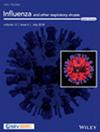Prevalence of Respiratory Viruses in Children With Acute Respiratory Infections in Shanghai, China, From 2013 to 2022
Abstract
Background
A variety of viruses can cause acute respiratory infections (ARIs), resulting in a high disease burden worldwide. To explore the dominant viruses and their prevalence characteristics in children with ARIs, comprehensive surveillance was carried out in the Pudong New Area of Shanghai.
Methods
Between January 2013 and December 2022, the basic and clinical information, and respiratory tract specimens of 0–14 years old children with ARIs were collected in five sentinel hospitals in Shanghai Pudong. Each specimen was tested for eight respiratory viruses, and the positive rates of different age groups, case types (inpatient or outpatient) were analyzed.
Results
In our study, 30.67% (1294/4219) children with ARIs were positive for at least one virus. Influenza virus (IFV) was the most commonly detected respiratory virus (349/4219, 8.27%), followed by respiratory syncytial virus (RSV) (217/4219, 5.14%), para-influenza virus (PIV) (215/4219, 5.10%), and human coronavirus (HCoV, including 229E, OC43, NL63, and HKU1) (184/4219, 4.36%). IFV was the leading respiratory virus in outpatients aged 5–14 years (201/1673, 12.01%); RSV was the most prevalent respiratory virus in both inpatients (61/238, 25.63%) and outpatients (4/50, 8.00%) for ARI patients aged <6 months old. For PIV, HMPV, HCoV, and HRV, the risk of infection usually was higher among young children. Co-infection with more than two viruses was seen in 3.25% (137/4219).
Conclusions
IFV and RSV played important roles in ARIs among children, but the risk populations were different. There are needs for targeted diagnosis and treatment and necessary immunization and non-pharmaceutical interventions.


 求助内容:
求助内容: 应助结果提醒方式:
应助结果提醒方式:


